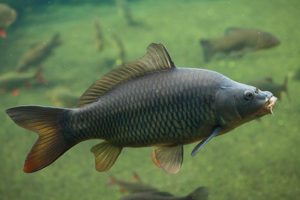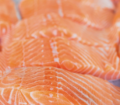 What’s one of the best ways to sharpen your bowhunting skills in the off season? Hunt the water for one of Iowa’s abundant rough fish species!
What’s one of the best ways to sharpen your bowhunting skills in the off season? Hunt the water for one of Iowa’s abundant rough fish species!
Carp, buffalo, sheepshead, gar and suckers are all fair game in most Iowa waters. And most bodies of water are open to bow fishing. As always, check the regulations before heading out on specific bodies of water.
Bowfishing is a great way to fine-tune one’s bowhunting skills:
1. It requires stealth. Just like whitetail hunting, too much movement will spook the animals. Learning to remain still and move slowly is key.
2. It builds strength. Holding a bow at full draw while waiting for a massive carp to swim into range is a great way to build arm strength for the bow hunting season!
3. It helps build accuracy. Becoming accurate with a recurve, compound or crossbow requires repetition. The more you shoot the more accurate your shooting will become.
When is the best time to bowfish?
The best time to bow fish is during the spawn when the fish are in the shallows and present easier shots. Most rough fish like carp in Iowa normally spawn in late May or very early June.
The exact timing of the spawn is dependent upon water temperature levels. Carp generally hit the shallows when water temperature levels are in between 68-73 degrees. Occasionally climbing water levels can cause the spawn to kick off early, however, water temp is the secret and in most cases the deciding factor.
Typically, a lot of the carp and rough fish in a given lake, stream or river system will spawn at the same general time so once spawning fish are located in one area there’s a good chance the entire body of water will start to get good.
Gear Up For Bowfishing
All types of bows can be used for bow fishing. It’s best to use a bow with a draw weight of over 50 pounds to ensure the arrow will have enough power to penetrate the water and the fish.
Modern bows are loaded with bells and whistles and different features that can make bow fishing more enjoyable. If you intend to use a crossbow, it’s best to read crossbow reviews to ensure you buy a model that can be easily fitted with a bow fishing reel.
Bowfishing Arrows
There are three common varieties of bow fishing arrows: fiberglass, carbon, and also a crossbreed of the two. All are heavy and also durable and adequate to maintain sufficient power underwater to pass through the thick scales of the fish.
Arrow Tips
When it involves selecting the arrowhead point, it’s all about the varieties you’re after. Bowfishing arrow tips are barbed like fishing hooks. The barb prevents the arrow from popping back out of the fish when it is being pulled back in. Don’t go crazy and buy the most expensive bow fishing arrow tips you can find. Rocks and stumps eat up a lot of arrow tips, so plan on replacing them often.
Reels
The reel type can make break your bow fishing success rate. There are 3 types of reels out there, each with its pros and cons. These are the hand reel, the bottle reel, and the spin cast reel. Let’s have a look at each type.
Hoop Style Bowfishing Reels
The easiest type of bow fishing reel is the hand oy hoop reel. The ol’ faithful of the bow fishing world, the hand reel is nothing more than a drum or hoop with line wrapped around it in a manner that spools off easily. When a shot is taken the line spools off the reel with little to no resistance. As the fish is being brought back towards the boat the line is hand spooled back on the reel.
Not only is the hand reel straightforward to make use of, it’s also very dependable and they tend to be free of nooks and crannies that the line can snag on and break. It’s likewise one of the most budget-friendly kind of reels. The drum reel is a prominent choice among the traditional bow fishers, and it goes well with recurve, compound, and crossbows.
The disadvantage to the hand reel is that it takes more work to reel a fish in and if you miss it takes longer to re-spool the reel and prepare for another shot.
Container Style Closed Face Reel
The Closed Face Reel is possibly one of the most prominent bow fishing reels out there. They are trusted, and generally, make life a lot simpler than hand reels.
Closed face reels do have their drawbacks though. For one they don’t tend to hold a lot of heavy test line and reeling in can be a relatively slow process.
It’s also easy to forget to click the bail release button down before a shot is taken. This can be dangerous if the arrow snaps back at the shooter so be careful!
Spincast Reel
Spincast reels are what many purists consider the best of the best. It’s essentially an exact copy of an open face fishing reel installed on a bow, so it’s very straightforward and easy to use.
Spincast reels are nice because there is very little resistance as the line rolls off, creating more accurate shot placement. And reeling in with spin-cast reels is faster.
However spin-cast reels do tend to have more snag points on them, and the bail needs to be flipped before each cast, so be careful!
Ready, Aim, FIRE!
One of the hardest parts of bow fishing is hitting the target! Even though most shots are taken under 25 yards, hitting targets underwater can be tricky.
Due to how light refracts through water, things are not necessarily exactly where they appear. Because of this most newbies tend to shoot over their intended target.
As a general rule, you want to aim about 4 inches low for every 10 yards of distance. If you’re aiming at a carp that is 20 yards away, aim about 8 inches low to stick it with your arrow.
Fire Up The Smoker
Iowa’s waters are loaded with rough fish that can be legally bow-fished. Many of these fish species make excellent table fare when smoked. So don’t be bashful! Fire up the smoker and enjoy your quarry!
And if you don’t want to eat the fish, many farmers and gardeners will take your catch to use as fertilizer.
Bowfishing is a win-win proposition! You fine-tune your archery shooting skills for the fall hunting season while clearing the lakes of rough fish and invasive species that are becoming overabundant in many areas.
It’s a great way to get outside and on the water to enjoy the warm spring days as well!












